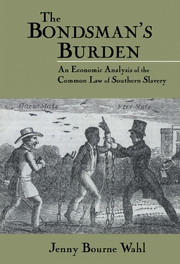Book contents
- Frontmatter
- Contents
- Acknowledgments
- 1 American Slavery and the Path of the Law
- 2 The Law of Sales: Slaves, Animals, and Commodities
- 3 The Law of Hiring and Employment: Slaves, Animals, and Free Persons
- 4 The Law Regarding Common Carriers: Slaves, Animals, Commodities, and Free Persons
- 5 The Law Regarding Governments, Government Officials, Slave Patrollers, and Overseers: Protecting Private Property versus Keeping Public Peace
- 6 The Legal Rights and Responsibilities of Strangers Toward Slaves, Animals, and Free Persons
- 7 Treatment of One's Slaves, Servants, Animals, and Relatives: Legal Boundaries and the Problem of Social Cost
- 8 The South's Law of Slavery: Reflecting the Felt Necessities of the Time
- Notes
- Index
7 - Treatment of One's Slaves, Servants, Animals, and Relatives: Legal Boundaries and the Problem of Social Cost
Published online by Cambridge University Press: 24 October 2009
- Frontmatter
- Contents
- Acknowledgments
- 1 American Slavery and the Path of the Law
- 2 The Law of Sales: Slaves, Animals, and Commodities
- 3 The Law of Hiring and Employment: Slaves, Animals, and Free Persons
- 4 The Law Regarding Common Carriers: Slaves, Animals, Commodities, and Free Persons
- 5 The Law Regarding Governments, Government Officials, Slave Patrollers, and Overseers: Protecting Private Property versus Keeping Public Peace
- 6 The Legal Rights and Responsibilities of Strangers Toward Slaves, Animals, and Free Persons
- 7 Treatment of One's Slaves, Servants, Animals, and Relatives: Legal Boundaries and the Problem of Social Cost
- 8 The South's Law of Slavery: Reflecting the Felt Necessities of the Time
- Notes
- Index
Summary
I'll conquer ye, or kill ye! – one or t'other. I'll count every drop of blood there is in you, and take 'em, one by one, till ye give up!
– Simon LegreeUncle Tom's Cabin paints for many people the quintessential picture of relationships between masters and slaves: Harriet Beecher Stowe portrayed in fiction what scholars have since documented in fact. According to court records, antebellum Southern judges helped frame these relationships. They granted masters generous leeway in their discipline of slaves, tolerating even the viciousness of real Simon Legrees as long as the abusive behavior did not affect the community. This practice had economic as well as political and social roots: Privately administered “plantation law” cost less to carry out than public law, at least to those other than slaves. But court proceedings show that many slaveowners also treated their human property compassionately – caring for slaves in old age, granting slaves small favors, keeping slave families together, and protecting illegitimate slave children from wrathful wives. To a degree, Southern judges supported benevolence toward slaves, even when such kindness apparently contradicted statutes. Why? Certainly some judges must have been motivated by humanitarian instincts or a desire to protect the powerless. But judges' opinions also indicate their beliefs that good treatment of slaves could enhance labor productivity, increase plantation profits, and reinforce the sentimental ties between master and slave. Courts also accepted masters' use of slaves as agents when doing so lowered overall costs of production and distribution.
When the treatment of one's slaves might have inflicted costs on other parties with legal standing, however, judges stepped in to regulate the master's behavior.
- Type
- Chapter
- Information
- The Bondsman's BurdenAn Economic Analysis of the Common Law of Southern Slavery, pp. 142 - 173Publisher: Cambridge University PressPrint publication year: 1997

